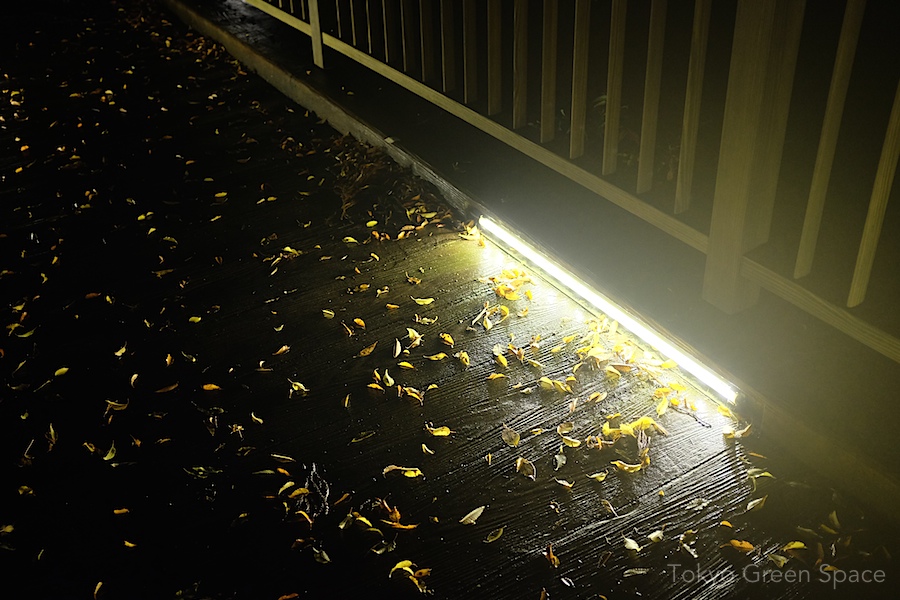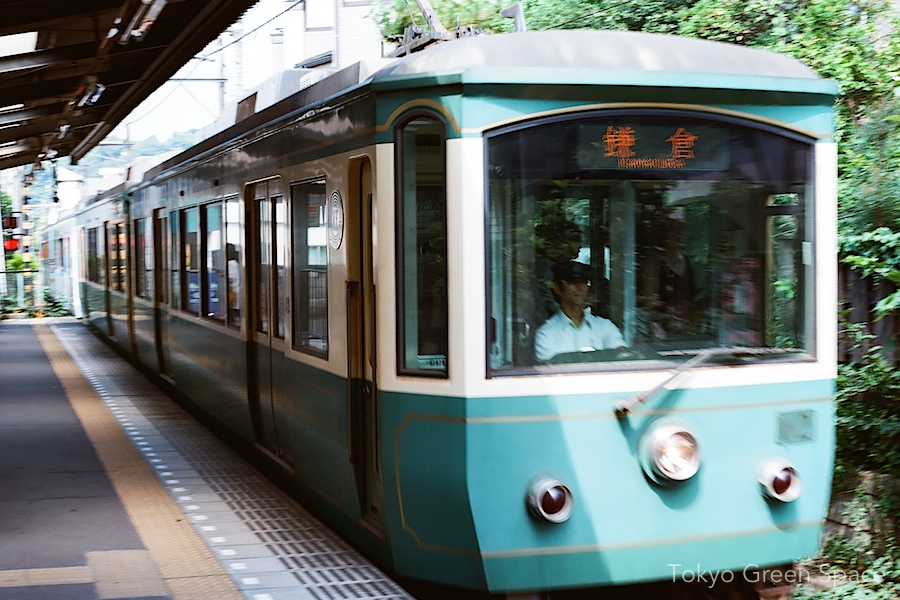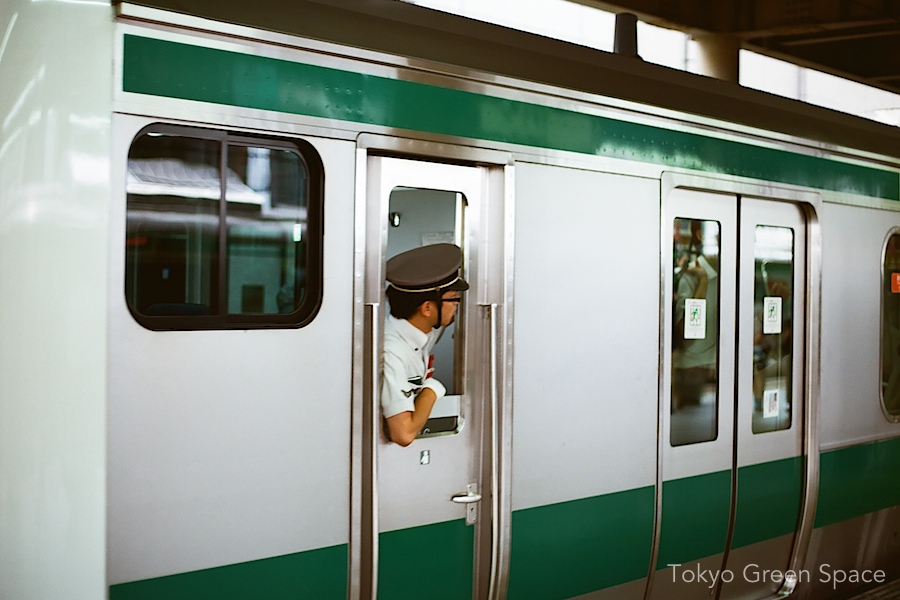train
A very urban, summer scene, with yukata sidewalk party, Odakyu train, and office tower
Train lover’s paradise on Kamakura’s Enoden train
Safety check on departure
Kita Kamakura looks elegant, even from inside the train

電車から、きれいな北鎌倉の自宅の写真をとりました。駅の仕切りの格子は自宅の木の塀と調和しています。木の塀の下に、夏の草がたくさん生えています。
I spotted this lovely Kita Kamakura house from inside the train. I like how the station uses a simple screen that echoes the house’s wood fence. I also love how the summer weeds are running rampant at the bottom of the fence.
Lone pine in beach parking lot

三浦海岸は東京湾の下の方にあります。東京から電車で行きやすいです。夏の涼しいスポットです。
Miura Kaigan is at the bottom of Tokyo Bay, and easily reachable by train from Shinagawa. Another cool spot to relax during the heat of summer.
The beach is a fast train ride away in Chiba

千葉の御宿に着くと、きれいなヤシの並木が見えます。細くて背が高いです。カリフォルニアに人気なメキシコのヤシみたいです。急行で行くと、東京から御宿は近いです。電車からの東京湾の景色が大好きです。
I love how this row of skinny palm trees greets visitors to Onjuku, Chiba right from the station. They look like Mexican fan palms (washingtonia robusta) which are very common in California.
Onjuku is an 80 minute ride on the express train, and the beach is a 10 minute walk away. It’s great to visit the beach even for an afternoon. The trip by train is also fun. I love to see the port buildings and activities.


Nakano station remodel connects riders to 1970s Sun Mall

駅の新しい改札口がオープンしたときに、大きい花のディスプレイを送るのは、たぶん日本だけだと思います。JR中野駅北口のために、桜祭り協会もサンモールの協会も花を送りました。中野駅、おめでとう。
I love how there are huge flower displays celebrating the opening of the remodeled Nakano JR north exit. It’s a commercial tradition, extending to the opening of ramen shops and bars, too. These huge flower displays are from the Sun Plaza merchants association and the Nakano sakura festival organizers. I hope the redesigned plaza opens soon with a lot of new trees and plants!

Leap Day snow falling on the Sobu line train

Leap Day in Tokyo saw a surprising amount of snow, falling in large gobs from the sky and from roofs. Someone tipped me off that the trains are less impacted than the underground subway, and that snow slows the city less than rain. I took photos of a routine trip from my home.
The snow helped me see Tokyo again from a fresh perspective.
Nonbei Yokocho

Between the new Miyashita park and Shibuya station, I came across this lovely alley called Nonbei Yokocho, full of tiny bars. Maybe because it’s next to the train tracks, a marginal urban space, this collection of old houses built before or just after the war have survived. I love the weeping willows, the lanterns, and the reminder of Shibuya’s earlier incarnations.
Pleasures of Tokyo trains and subways

It’s hard for people outside Tokyo to imagine what using Tokyo transit is like. The busiest station, Shinjuku station, handles over 2.5 million users per day, more than any other station in the world. And, yes, early morning rush hour and the last trains around midnight are not comfortable. This photo is from 10:23 am on a Saturday morning in the Marunouchi line, and you can see that the train is quite full.
What does it feel like to be surrounded by so many people on your way to work, school, errands, or fun? Office workers, school children, families, construction workers, teens, dogs in bags, babies, elderly people. I find it exhilarating, intimate, and educational. Mostly people pretend they are in their own space and do not look directly at others. Courtesies include taking children’s shoes off before letting them stand on the cushioned seats, and drying umbrellas to keep the train clean.
Many people hide behind earphones, portable game players, comics and books. Others are sleeping. Yet there is no mistaking that you are in a shared space, one person among masses going about their lives. If you keep your eyes open, you can sense that others are also quietly observing. Taking the train is a good way to get out of your own head space, and sense other people’s moods, fashions, and presence.
Joan’s small farm in western Tokyo
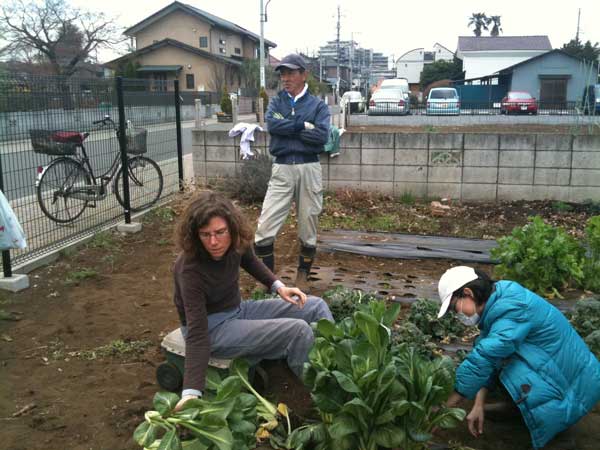
友達のジョアンは西東京の駅の近くで畑を作っています。ジョアンに野菜をたくさんもらいました。夏のポテトサラダに使うために、ベルガモットもくれました。
Fifteen minutes on the express train and four blocks from the station, my friend Joan is farming a small plot of land. It’s actually several short rows that form part of a much larger city farm owned and operated by a Japanese retiree. As soon as I saw him, I was glad that I, too, had prepared for weeding and harvesting by wearing the all important white work towel.
Joan blogs and writes about urban farming, farmers’ markets, city landscapes, and Japan travel. It was very exciting to actually see Joan at her farm. I was impressed that she had also recruited a neighbor and her husband’s co-worker to help with tidying up the winter beds, getting ready for planting, and harvesting and taking home the last winter vegetables. There was a huge leafy bounty that Joan shared with us: Russian kale, red karashina, brocoli, spinach, komatsuna, and shungiku. Joan also sent me home with some bergamot that I am growing on my balcony. I am still waiting for Joan’s famous bergamot potato salad recipe. And I was able to share what Joan gave me with three other households.
We all gathered at the farm just two weeks after the Tohoku quake, tsunami and nuclear crisis. It was great to be outdoors, talking about city vegetables, chatting with friends and new acquaintances. I liked hearing about Joan’s permaculture ideas of doing less, leaving flowers to attract pollinators, and hand mowing rather than eliminating the weeds between rows. The Japanese man who owns the farm clearly has a different attitude since he keeps his farm empty of all plant life except for the vegetables he grows. I can sense that Joan and the farmer each want to show the other how to farm. There’s both conflict and mutual respect for each’s passion for city farming.
I hope to go back as often as I am invited.

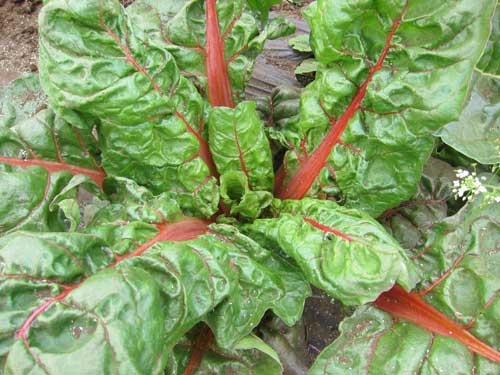



Origami Mount Fuji celebrates 125th anniversary of Shinjuku station

折り紙の壁画が世界で一番大きい駅の125周年を祝っています。
This giant origami mural celebrates Shinjuku station’s 125th anniversary. Tokyo boasts many mega-stations, including Tokyo Station, Shibuya, Shinagawa, and Ikebukuro. Yet Shinjuku station is the most used station in the world, with an estimated 3.4 million daily riders on train lines operated by five different rail companies.
I love how the anniversary is commemorated with this origami art work composed of thousands of cranes. The images chosen are iconic for Tokyo: Mount Fuji, a cherry tree, the Tokyo Metropolitan Government’s twin high-rise from the 1980s, and a rainbow. The only thing missing is the station itself; however, with no main entrance, the station is less a destination than a passageway to other places.
Recently in San Francisco, my friend told me about his rapid transit station’s 40,000 riders, which is a significant number. That figure is just over 1% of Shinjuku’s traffic. It is impossible to overstate the role of trains in making Tokyo function as an efficient and low carbon city.

Sunset on Tokyo’s trains

Tokyo’s great transit system allows you to go many places without a car. You can enjoy the scenery and meeting many people.
電車がたくさんあるので、車なしでいろいろな所へ行けます。多くの人に会えるし、きれいな景色を楽しめます。
The days are getting shorter, and with clearer skies the sunsets are remarkable. Recently I have been enjoying the views from elevated trains and stations. Trains in Japan are always punctual, clean and efficient. And apart from peak commute times, you can relax and enjoy the peacefulness of leaving the driving to others. Tokyo’s superior urban transportation system allows for a city where private cars are not the main form of mobility. It is still surprising to me how much walking, biking, conversation, playing, and reading dominates Tokyo’s many small streets, with the occasional car slowing down to pedestrians’ pace.

Green wall outside liquor shop at Nishi Ogikubo station

Liquor shop’s green wall captures attention at JR station in Nishi Ogikubo.
西荻窪駅で、酒屋の緑の壁は注目を集めります。
I like this green wall surrounding the Dila liquor shop as you exit the Nishi Ogikubo JR station. It brightens up the station entrance and draws attention to the shop. It looks like the same type of wall system and plants that Marui uses inside its Shinjuku san-chome store and in the basement near the subway.
I hope this trend catches on, and more commercial spaces see the benefits of green walls. It would be great to see a greater variety of plants, rainwater catchment and re-use, and habitat creation. For now, any green wall catches attention, but perhaps soon there will be more experimentation and creativity.
